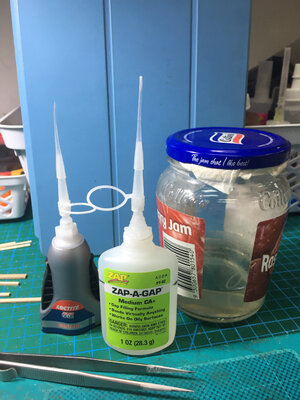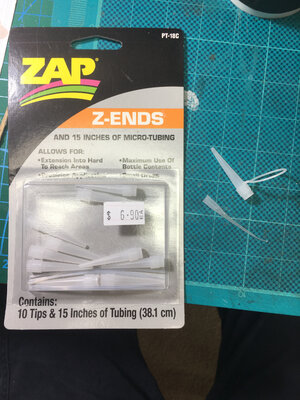Kurt Konrath
Kurt Konrath
Thanks for the tip, I often keep a small bowl of water near work station to dip fingers or towel into to help clean work surface or fingers when gluing with wood glue.
Rick,
Probably superfluous, but did you form the wale to match the curvature?
Too much tension on the bond and you're in trouble.
Johan
the form I use does match the hull . I thought if I equaled the shape that it would be a better fit.Rick,
Probably superfluous, but did you form the wale to match the curvature?
Too much tension on the bond and you're in trouble.
Johan


Use the white capillary tubes from Amazon that you can buy in quantity. You attach these to the bottle and if they clog, you merely cut off a short portion and the glue is available again. If they get bad, you replace them. Keep the bottle vertical between uses.
Those are useful tips. Thanks for sharing.I keep a jar filled with acetone handy. Also have two CA caps, one on the bottle and one in the acetone. When one gets clogged I switch them out. Works great!
These are great tips that Bob Hunt put me on to through his practicums. I use Zap-a-gap medium CA. The long micro tips are perfect, especially when you get to rigging and those hard to reach places. Just dab the tip on a Kleenex between uses and it will remain open. I keep a bottle of nail polish handy and use it on a cloth when I get CA on the finger tips. Can't do without it!This is a excerpt of an on-line article I copied sometime ago so I don't remember the source dealing with keeping CA tips clean:
"GLUE TIP CLEANING The best cleaner that I've found for CA glue is acetone. I get glue tips, to last just about indefinitely by storing them in a small jar of acetone between uses. I just drop the glue tip into the acetone and make sure that it's fully submerged. The acetone dissolves all of the CA glue out of the glue tip without causing any damage to the tip itself. When I next need to use it, I fish it out of the acetone with a pair of tweezers, touch the end to a bit of facial tissue, then blow air through the back end (without touching it to my mouth) so that the last of the acetone ends up on the facial tissue and it's as if I have a brand new glue tip. One does have to keep an eye on the level of the Acetone in the jar, as it seems able to evaporate through any type of seal, and when you start to see stuff swirled through the acetone, it means that it has absorbed lots of CA and needs to be replaced.
Note: If acetone is not a familiar word to you, it is the primary ingredient in nail polish/nail varnish remover - the part that stinks. You should be able to buy it small (0.5 liter/quart to 1.0 liter/quart) cans/tins in almost any hardware store that sells house paint, etc."
Nail polish REMOVER.......? I use acetone. Buy it by the gallon too...These are great tips that Bob Hunt put me on to through his practicums. I use Zap-a-gap medium CA. The long micro tips are perfect, especially when you get to rigging and those hard to reach places. Just dab the tip on a Kleenex between uses and it will remain open. I keep a bottle of nail polish handy and use it on a cloth when I get CA on the finger tips. Can't do without it!

Perhaps and it seems to work for me. There are long plastic tips that fit over the tip of the supper glue and it seems to help. When the tip gets clogged you snip a small amount of the tip off. A second which I like better is after your done for glueing for the day place just a small piece of paper town over the end of the plactic tip. Just pinch the towel over the tip and leave it. The next time you go to use it pull the piece of town away and the tip should remain clear.I have yet been able to use super glue without it getting clogged. Is there a trick to keeping it unclogged so you can use the whole bottle?
why do you place the glue in the freeze, is this part of the storage instructions, or ?I'll use Loctite superglue. Loctite 454 gel for wood or Loctite 401 for metal and painted surfaces. I put the glue in the freezer so it is always usable
I use Colle 21 https://www.colle21.com/I have yet been able to use super glue without it getting clogged. Is there a trick to keeping it unclogged so you can use the whole bottle?
I store the glue in the freezer so that there isn't so much oxygen that combines with the humidity in the air with the glue. This makes the glue viscous and unusable. The storage description states that the adhesive should be stored in a cool and dry place. In addition, no glue sticks to the pipette in the freezer and you don't need a needle etc. to close it.why do you place the glue in the freeze, is this part of the storage instructions, or ?

I learnt 2 things early when I started using CAs to glue model kits : The tops of glue bottles clog up irrespective of the brand of glue or the manufacturer's efforts to encourage this to happen as quickly as possible after first opening the seal on the fresh bottleI have yet been able to use super glue without it getting clogged. Is there a trick to keeping it unclogged so you can use the whole bottle?


